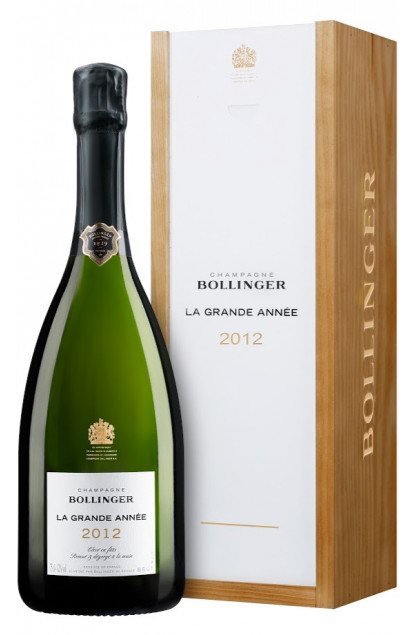Viewed 903 times...
Bollinger La Grande Annee 2012 Champagne
Short Description
It is a champagne that was vinified in small French oak barrels then aged in the famous chalk cellars of the house for optimal aging.
This is an extraordinary blend of 21 crus: mainly Aÿ and Verzenay for Pinot Noir at 65%. Le Mesnil-sur-Oger and Oiry for the Chardonnay (35%).
The color is a magnificent Versailles Gold. It is delicately tinted with golden reflections, witnesses of the maturity of the wine.
On the nose: toasted and fruity and slightly vanilla notes. Full and expressive. Apricot, almond and hazelnut, but also honey and cereals respond to each other in a veritable symphony of aromas.
On the palate: affirmations of the sensations of the nose with a remarkable silkiness. Its freshness and smoothness are accompanied on the finish by beautiful bitters.
A good aging potential in the cellar away from light, noise and the bottle lying down with successive tastings in order to measure the evolution of the wine until its qualitative climax.
To be served at a temperature around 10 degrees, throughout a meal with scallops, sorrel and vanilla. Grilled oyster, smoked butter and sea purslane. Hen of the woods, potato and truffle emulsion.
Perfect on an apricot or blueberry pie. Would go even better on a dark chocolate cake.
The origin of the Bollinger House is Athanase de Villermont (born in Cuis in 1763 and died in Aÿ in 1840), a marine officer in the French army, who excelled during the US independence war, most notably during the Chesapeake battle on the 29th of April 1781.
A few years later, he inherited a vast family estate around the town of Aÿ, a territory well-known for the wines of Aÿ, that would later be named “Champagne”. His origins didn’t allow him to devote himself to trade, so he had the great idea to create in February of 1829 a House of Champagne wines, in the form of a company. The House is named Renaudin-Bollinger and Co: Joseph Bollinger would take care of trade while Paul Renaudin would be cellar master.
Joseph Bollinger married Louise-Charlotte in 1837, daughter to Athanase de Villermont. Joseph was born to this married couple, followed by Georges. Both faced with courage and success the Phylloxera crisis in 1875 and 1895 and the Great war. Jacques Bollinger, son of Georges, became head of the House in 1920, and married Elizabeth Law de Lauriston-Boubers in 1923, who became a widow during the second World War but kept managing the Bollinger House on her own.
The Bollinger generation carried on and in 1994, the House is managed by Joseph Bollinger’s great grandson.
While the family still owns it, the House is currently managed for the first time in its history by a stranger, Jérôme Philippon, a talented manager with a great career path.
The Bollinger House, which has been for almost two centuries constantly in search for excellence, is one of the last few houses to still have a cooper. He cares every day for 3.500 barrels, among which some are more than a 100 years old. An expertise that the House aims to sustain.
Long Description
| Details: | |
| Wikipedia: | Visit |
| Manufacturer: | ? |
| Origin: | |
| Barcodes: |

| Nutrition Facts | |||
|---|---|---|---|
| Serving Size: | |||
| Ammount per Serving: | |||
| Calories: | kcal | ||
| Details in % | Daily Value | ||
| Total Fat | % | g | |
| Satured Fat | % | g | |
| Trans Fat | % | g | |
| Polyunsatured Fat | % | g | |
| Monounsatured Fat | % | g | |
| Cholesterol | % | mg | |
| Sodium | % | mg | |
| Potassium | % | mg | |
| Total Carbohydrate | % | g | |
| Dietary Fiber | % | g | |
| Sugars | % | g | |
| Other carbohydrate | % | g | |
| Protein | % | g |

